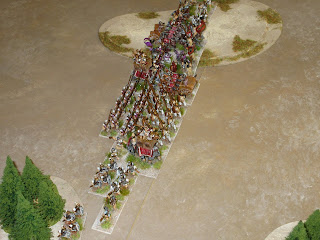The kingdom of Armenia is the latest opponents for the
Seleucid. Historically, the Satrapy of Armenia was part of the Seleucid Empire and
at times the Seleucid kings would need to remind them of their allegiance. These
conflicts involve primarily the royal houses of the Orontid and the Artaxiad.
Readers wishing to dig deeper in the period I would recommend the CambridgeHistory of Iran, volume 3; the Seleucid, Parthian and Sassanid period, part 1.
II/19c Seleucid
1 x general (3Kn), 1 x cataphract (3Kn), 1 x elephant
(El), 1 x scythed chariot (SCh), 4 x phalanx (4Pk), 2 x thureophoroi (4Ax), 1 x
Cretan archer (Ps), 1 x slinger (Ps).
II/28b
Armenia
1 x general (4Kn), 1 x cataphract (4Kn), 4 x horse
archers (LH), 4 x tribesmen (3Ax), 2 x archers (Ps).
Game one
Armenia as defender placed three difficult hills and
two woods. As attacker, the Seleucid denied the Armenian the better ground and
both sides deployed for battle.
Armenia had split her infantry into two wings with objectives
to seize the high ground and flank the Seleucid line. Her cavalry would move
forward when those objectives were reached. On the hilltop, Greek skirmishers
were kept busy by the Armenian javelinmen and their archers managed to slip
past to set up position to shoot at the phalanx. The Seleucid moved the chariot
forward to extend the main line.
Armenia timed her assault well breaking up the
Seleucid battle line; this action did cost some light horse but opened opportunity
for the javelinmen to work around exposed flanks. Armenia gained full possession
of the hill and the phalanx were feeling the danger from above while having
their attention held to front by the light horse. Despite the losses being even
for both sides (2 - 2), the loss of the elephant opened a huge gap now quickly
filled by Armenian cavalry.
The battle quickly turned into a brawl which the
Greeks would not regain their control; subsequent losses to both sides gave the
Armenian a victory of 4 – 3.
Game two
The tables were turned and the Seleucid placed terrain
which Armenia selected the most advantageous for her deployment.
The Seleucid line wheeled to the left leading with a
mixed brigade of scythed chariot and auxiliaries while the phalanx wheeled on
the spot to form an oblique formation. The Armenian light horse moved to a
flanking position but the Seleucid reserve cavalry were ready.
The Seleucid right connected and did the job they were
expected to do. One the Seleucid left, the elephant met an early death from
Armenian bow. Score was still even 2 – 2.
The scythed chariot ground to a halt and was taken out
by javelinmen, but the Galatians were experiencing a “blood lust” and two enemies
to end the game, 3 – 4 for the Seleucid.
Game
three
As attacker, the Seleucid deployed with two difficult
hills anchoring her right which altered the usual deployment; the elephant and
scythed chariot formed up to the left of the phalanx. The Armenian positioned
at the end of the valley placed all her cavalry in the centre and split her
infantry into two wings.
Securing the hill on the right, the Galatians and
lights were position to support the phalanx when it moved forward. The Armenian
light horse threatened the Greek left flank, but to their embarrassment, they
were surprised at the tenacity of the Cretan archers.
As a tightly wound spring the entire Seleucid line surged
forward; the phalanx crashed into Armenian javelinmen sending one tumbling to
its death, the elephant dispatched the cataphract cavalry while the Armenian
general breached the Greek wall by destroying the scythed chariot. The Cretans
smartly moved away from the Armenian light horse to let the Companions and
Agema move forward.
The phalanx made short work of its opposition while
the elephant was herding its enemy in the direction of the Armenian camp. The Armenian
general having no support nearby was quickly encircled and met his death ending
the game, 1 – 4 for the Seleucid.




























































